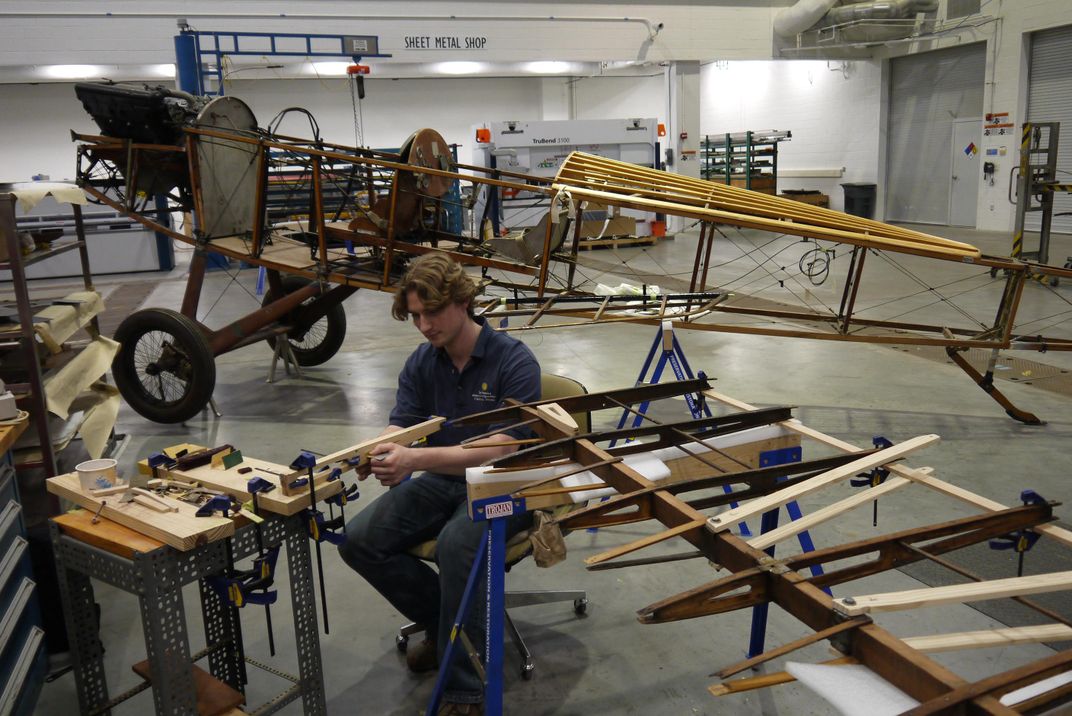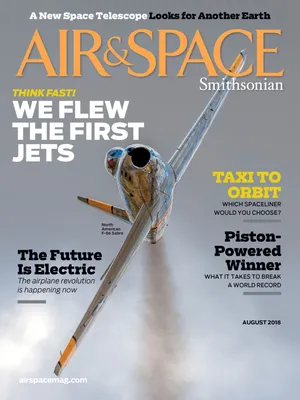Hands on History
As a restoration specialist at the National Air and Space Museum, Chris Redderson gets to work on some of the world’s most famous airplanes.
:focal(1980x971:1981x972)/https://tf-cmsv2-smithsonianmag-media.s3.amazonaws.com/filer/ef/40/ef409579-ff58-4f06-a8f9-390056717d76/01c_aug2018_spiritpic1_live.jpg)
Reddersen and colleagues are currently working on a Lincoln-Standard H.S., a three-place version of the World War I trainer, the Standard J-1.
The job: Reddersen has helped restore some of the most famous aircraft in the National Air and Space Museum collection: the Spirit of St. Louis, the Bell X-1, and the Martin B-26 Flak-Bait, the medium bomber that flew more missions over Europe—207—than any other U.S. airplane.
Typical day: Although there is no typical day in the restoration hangar at the Steven F. Udvar-Hazy Center, Reddersen says, his days have recently begun the same way: “I walk in nice and clean and within three to five minutes of working on the airplane, I’m coated head to toe in sawdust. For the past couple of weeks, I had been making new ribs for the horizontal stabilizer [of the Lincoln-Standard], but I’ve transitioned to using a router [on one of] the spars for it.”
On Flak-Bait, Reddersen did very different work. “We did a total tear-down of the engines, pulled the cylinders off, pulled all the gearing out, and treated all of the corrosion that had developed inside the engine. The engines looked like boat anchors. We dug pounds of grit out from the cylinder cooling fins. We have some magic chemicals that we’ve been given by conservation; they form a stabilizing layer in the pits the corrosion has formed.
“Most people in my field have done things when they were teenagers like take apart a lawn mower engine or something. I joke with my friends that the first engine I ever took apart was an 18-cylinder radial.”
How did you become interested in restoring historic airplanes? “I was about 8 years old when my dad took me to an open house at the Museum’s Garber [Restoration and Preservation] facility [in Suitland, Maryland]. I vividly remember that when we were looking at the Seiran Japanese floatplane, I thought, ‘Oh, that is the coolest thing in the world.’ I knew at that exact moment that the only thing I ever wanted to do was work on historic airplanes.”
He also watched all the re-runs of the 1970s TV series Black Sheep Squadron.
The path: After getting a degree in aerospace engineering from Virginia Tech, Reddersen contacted “every airplane restoration place I could think of asking, ‘How do you get into doing this?’ ” Then at a meeting of the local chapter of the Experimental Aircraft Association, he met Anne McCombs, who works in the Museum’s restoration shop. She arranged to bring him on as a volunteer on the crew that dusted and cleaned airplanes on display.
“And because I was unemployed,” Reddersen says, “I could basically volunteer 40-plus hours a week. I was just trying to build up skills so I could make myself more useful to the organization. I managed to display an aptitude” and got to work with staff on restorations. “They kind of took me under their wing. I spent the better part of two years as a volunteer.”

Did you have the feeling that if you just hung in there long enough, you’d get a job there? “I felt so completely blessed to have gotten as far as I had that I didn’t allow myself to think that much about it because I didn’t want my hopes to get let down if something didn’t work out.”
Skills needed for the job: “For the Lincoln-Standard, an ability to teach yourself the way things were done in the past. All of the woodworking repairs that we’re doing were the general practice for repairs in the 1940s. We’re doing seemingly thousands of standard scarf joints [end-to end joints, used in this case to install pieces of wing ribs]. In order for it to be an aviation-grade scarf, you have to do it at a certain angle, and that standard was determined back in the ’20s, ’30s, ’40s.
“It’s hard to believe that [the airplane] first flew about 100 years ago. That is a really cool thought.”
Best thing about the job: “I love the human touch in all of these artifacts. That’s what draws me to restoration: being able to connect to people who came before me. It’s such a small thing, but one of my favorite things that I’ve seen on any project was on Flak-Bait. On the inside of one of the exhaust panels, I found someone’s thumbprint that was etched into the back of the aluminum. And I’m just figuring this probably happened when this mechanic was out in the field and he pulled off this panel. It was still hot and he touched his thumb to it by accident. So he may have been saying some swear words, but for me finding that evidence of this person working on the airplane before me…. There have definitely been a couple of moments when I’ve gotten chills.
“And in what other job can you make the statement: Darn it. I can’t get to the sewing machine because the machine guns are in the way?”
